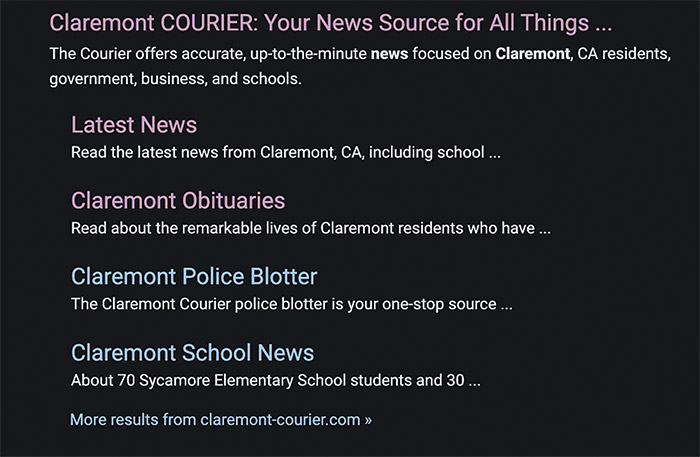What stories go unreported when a local newspaper fades?

by Peter Weinberger
Over the past several years I’ve talked repeatedly about what happens to a community when the local newspaper/website withers or dies, how losing a local news provider connected to so many facets of city life can impact the greater good more than most realize.
The Courier has also looked at business challenges differently than most. We not only changed to a nonprofit, but with the exception of cutting hours to survive the pandemic, have not reduced our editorial coverage by making staff cuts. It also helps that myself (and the board of directors) have not insisted on a consistent 20% profit margin. The Courier always reinvests any profit back into the business. This has kept resources focused on supporting quality journalism, while giving back to the Claremont community.
This column, however, focuses on the Salinas Californian, a 152-year-old newspaper/website with a long history of watchdog journalism. At one time the Californian had a staff of 120, including 35 writers and photographers. That editorial number in 2023 is now zero. The Californian’s lone reporter quit in December and has not been replaced. Print circulation has dropped from 11,000 to 2,500.
The Californian is owned by the largest newspaper publisher in the country, Gannett, which has continued to focus on cost cutting to stay alive. When that doesn’t work — which it hasn’t at the Californian — there are not many choices other than to stop publishing or sell at a bargain price. Think about this scenario: how can any media company keep readers when there are no reporters or editors to publish news? One day the Californian published five paid obituaries as their news coverage.
In Salinas, complaints about local reporting have come not only from the mayor and county supervisor, but residents as well, who say it’s impacted the city’s public life because there’s no source for objective news. “As a subscriber, seems like they (staff) are all gone and all local news has vanished from its pages! The end of an era?” Monterey County Supervisor Luis Alejo wrote recently on Twitter.
“Without a local paper in our city, we’ve lost the power to tell the stories of people in our city and the city itself. We’ve lost the power of storytelling,” said local business owner Trish Triumpho Sullivan.
What happened when Salinas stopped covering local news?
Stories went untold, keeping citizens less informed. Think of a high school sports competition where press coverage helps keep a fan base engaged. Readers talk about needing a watchdog for city hall. That’s a given. But city hall also wants to keep residents informed to spread information on important public events, policy issues, and debates. That includes participation in local elections, which are impacted by local news coverage, or lack thereof. Social media certainly helps, but the messages are often partisan. That’s not objective information. And of course the unfiltered comments make some topics a literal free-for-all of opinion and misinformation.
“There’s a void in the daily life of the community, not having that constructive presence,” said former Salinas Mayor Dennis Donohue.
Here’s just a partial list of local stories Salinas missed out on in recent weeks: an unidentified man was struck and killed by a train in early March; a court order was issued against a labor contractor to pay $460,000 in back wages and penalties to farmworkers; a dispute over whether a Saturday shutdown of Main Street is hurting businesses.
Industry impacted by big tech
Big tech corporations like Google and Facebook greatly impact the bottom line as they continue to publish our original content without compensation. And this issue impacts every local media business, whether public or privately owned. Google, for example, publishes up to 15 Courier stories each week as part of its news feeds. To be fair, they do include our name and story URL, but have eliminated the biggest and most important expense: paying professionals to report, write, and edit each story, photo, and video. The Courier spends more than $160,000 a year (not including myself) to pay its editorial staff.
Obviously, reader habits have changed dramatically as our lives have gone digital. Many see the newspaper business as a dying medium. I get that. But when a community loses a newspaper, it loses professionals that report and edit news objectively. And as recently as 10 years ago, newspapers had more staff dedicated to journalism than any other media business. More than television and even the internet.
The good news is there are plenty of supporters who donate time and money to help the mission of local news digital startups throughout the country. The Lendfest Institute’s mission is to support local media with grants and training. Even Los Angeles County supports media providers with grant relief for small businesses. And there are others too. The challenging part is the level of competition to secure grants is fierce and falls short of replacing job losses in the industry.
Assembly Bill 886, The California Journalism Preservation Act — proposed by Oakland Democrat Assemblymember Buffy Wicks — is a commonsense bill that would compel tech giants like Google and Facebook to pay a “journalism usage fee” when publishing original content created by local news providers like the Courier. In turn, we would commit to investing 70% of the profits from that fee in journalism jobs. Any idea to pay publishers for their original content is a smart and fair idea. Big tech already used its influence to fight passage of a similar bill proposed in the U.S. Senate in 2022, but in California, it just might happen.








0 Comments